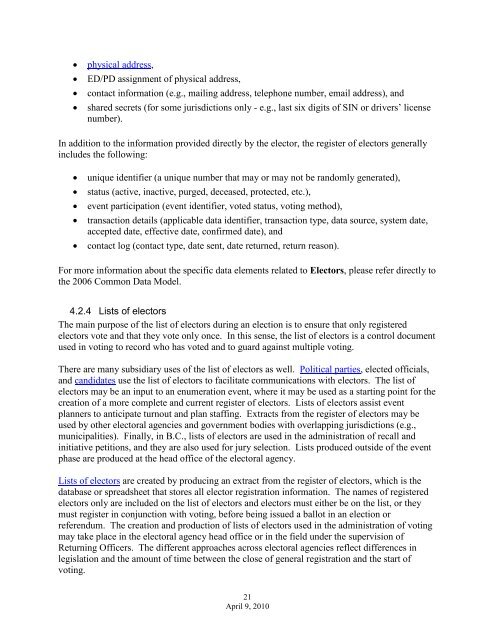Electoral-Management-Reference-Model-v.1.0
Electoral-Management-Reference-Model-v.1.0
Electoral-Management-Reference-Model-v.1.0
You also want an ePaper? Increase the reach of your titles
YUMPU automatically turns print PDFs into web optimized ePapers that Google loves.
• physical address,<br />
• ED/PD assignment of physical address,<br />
• contact information (e.g., mailing address, telephone number, email address), and<br />
• shared secrets (for some jurisdictions only - e.g., last six digits of SIN or drivers’ license<br />
number).<br />
In addition to the information provided directly by the elector, the register of electors generally<br />
includes the following:<br />
• unique identifier (a unique number that may or may not be randomly generated),<br />
• status (active, inactive, purged, deceased, protected, etc.),<br />
• event participation (event identifier, voted status, voting method),<br />
• transaction details (applicable data identifier, transaction type, data source, system date,<br />
accepted date, effective date, confirmed date), and<br />
• contact log (contact type, date sent, date returned, return reason).<br />
For more information about the specific data elements related to Electors, please refer directly to<br />
the 2006 Common Data <strong>Model</strong>.<br />
4.2.4 Lists of electors<br />
The main purpose of the list of electors during an election is to ensure that only registered<br />
electors vote and that they vote only once. In this sense, the list of electors is a control document<br />
used in voting to record who has voted and to guard against multiple voting.<br />
There are many subsidiary uses of the list of electors as well. Political parties, elected officials,<br />
and candidates use the list of electors to facilitate communications with electors. The list of<br />
electors may be an input to an enumeration event, where it may be used as a starting point for the<br />
creation of a more complete and current register of electors. Lists of electors assist event<br />
planners to anticipate turnout and plan staffing. Extracts from the register of electors may be<br />
used by other electoral agencies and government bodies with overlapping jurisdictions (e.g.,<br />
municipalities). Finally, in B.C., lists of electors are used in the administration of recall and<br />
initiative petitions, and they are also used for jury selection. Lists produced outside of the event<br />
phase are produced at the head office of the electoral agency.<br />
Lists of electors are created by producing an extract from the register of electors, which is the<br />
database or spreadsheet that stores all elector registration information. The names of registered<br />
electors only are included on the list of electors and electors must either be on the list, or they<br />
must register in conjunction with voting, before being issued a ballot in an election or<br />
referendum. The creation and production of lists of electors used in the administration of voting<br />
may take place in the electoral agency head office or in the field under the supervision of<br />
Returning Officers. The different approaches across electoral agencies reflect differences in<br />
legislation and the amount of time between the close of general registration and the start of<br />
voting.<br />
21<br />
April 9, 2010


